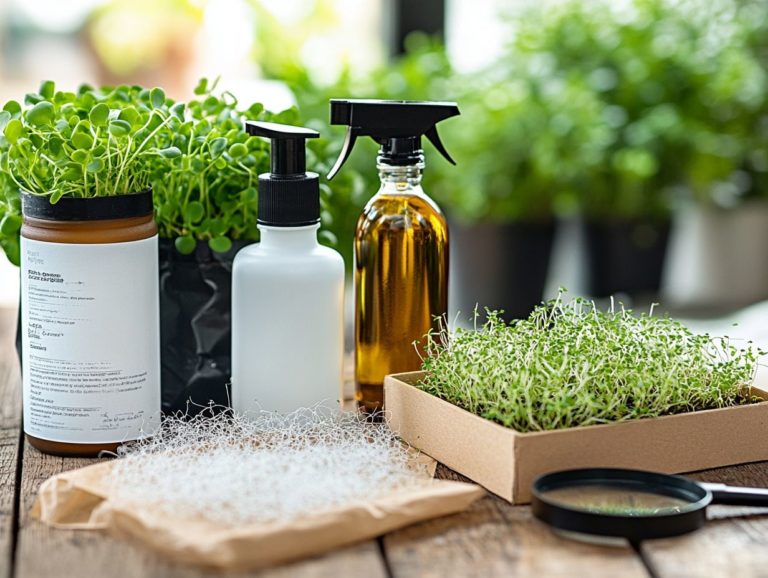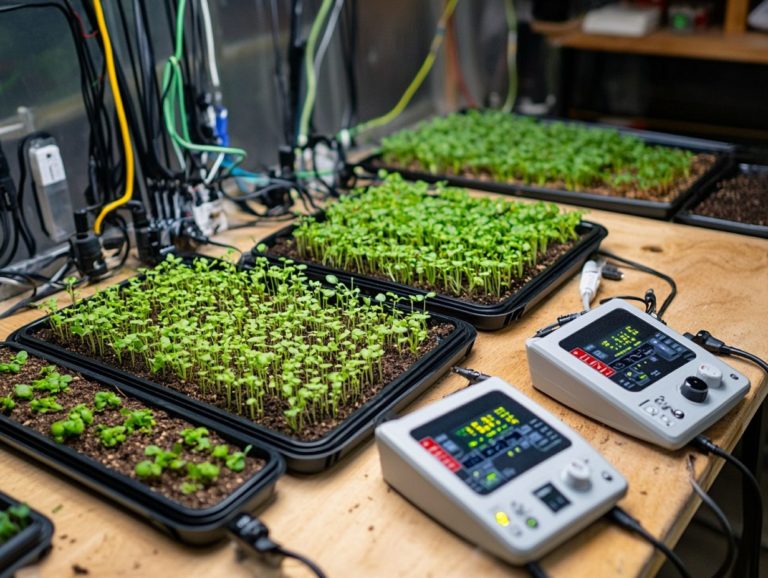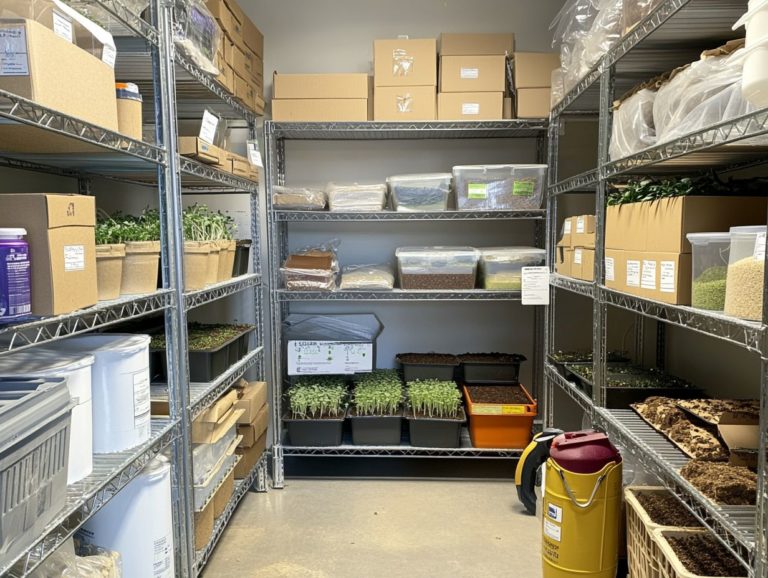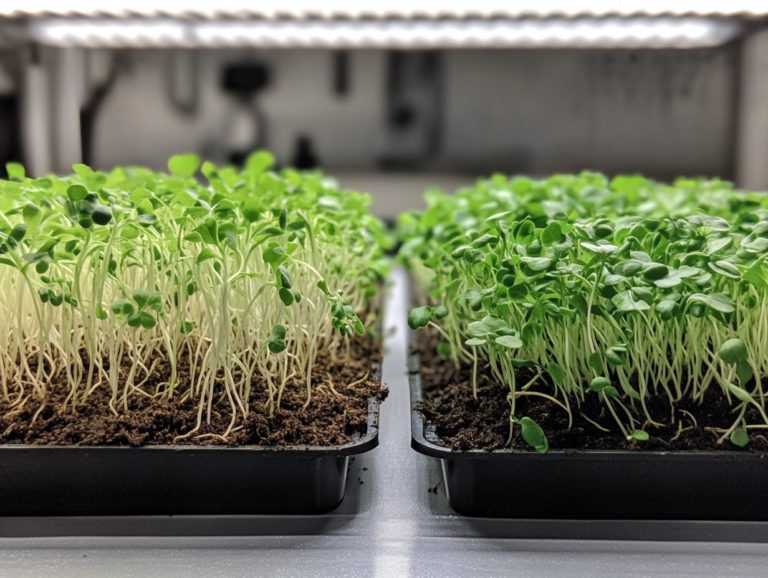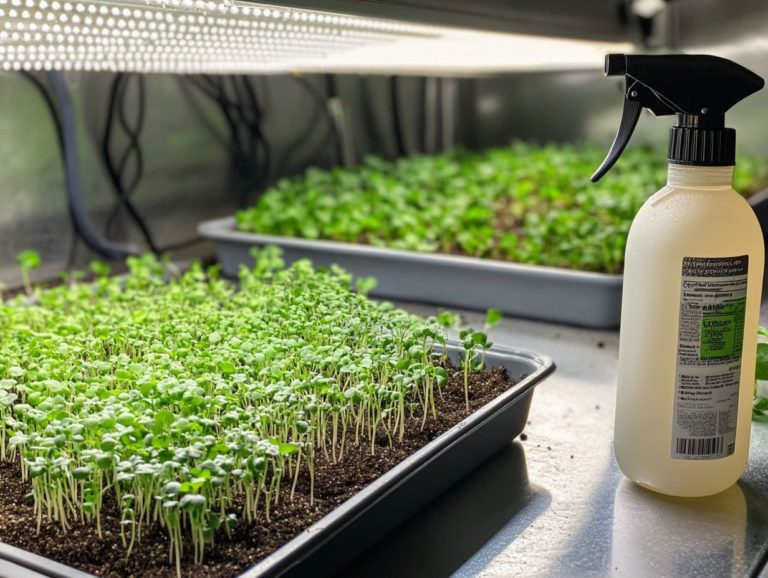Choosing the Right Nutrient Solution for Microgreens
Microgreens have truly transformed the culinary landscape, captivating taste buds not only with their vibrant flavors but also with their remarkable nutritional benefits.
Whether you re an experienced gardener or just beginning your journey, grasping the nuances of effectively cultivating these tiny greens is essential for unlocking their full potential.
This guide explores everything from the nutritional perks of microgreens to the finest nutrient solutions available, including both organic and synthetic options.
You ll discover the key factors to consider when selecting a nutrient solution, receive detailed, step-by-step instructions for mixing and applying it, and learn about common pitfalls to avoid.
By the end of this guide, you will be ready to take your microgreens to the next level!
Contents
- Key Takeaways:
- Benefits of Growing Microgreens
- Types of Nutrient Solutions for Microgreens
- Factors to Consider when Choosing a Nutrient Solution
- How to Mix and Apply Nutrient Solutions
- Common Mistakes to Avoid
- Frequently Asked Questions
- What is the importance of choosing the right nutrient solution for microgreens?
- What factors should I consider when choosing a nutrient solution for my microgreens?
- Can I make my own nutrient solution for microgreens?
- What are the common mistakes people make when choosing a nutrient solution for microgreens?
- How do I know if my microgreens are receiving the right amount of nutrients?
- Are organic nutrient solutions better for microgreens?
Key Takeaways:
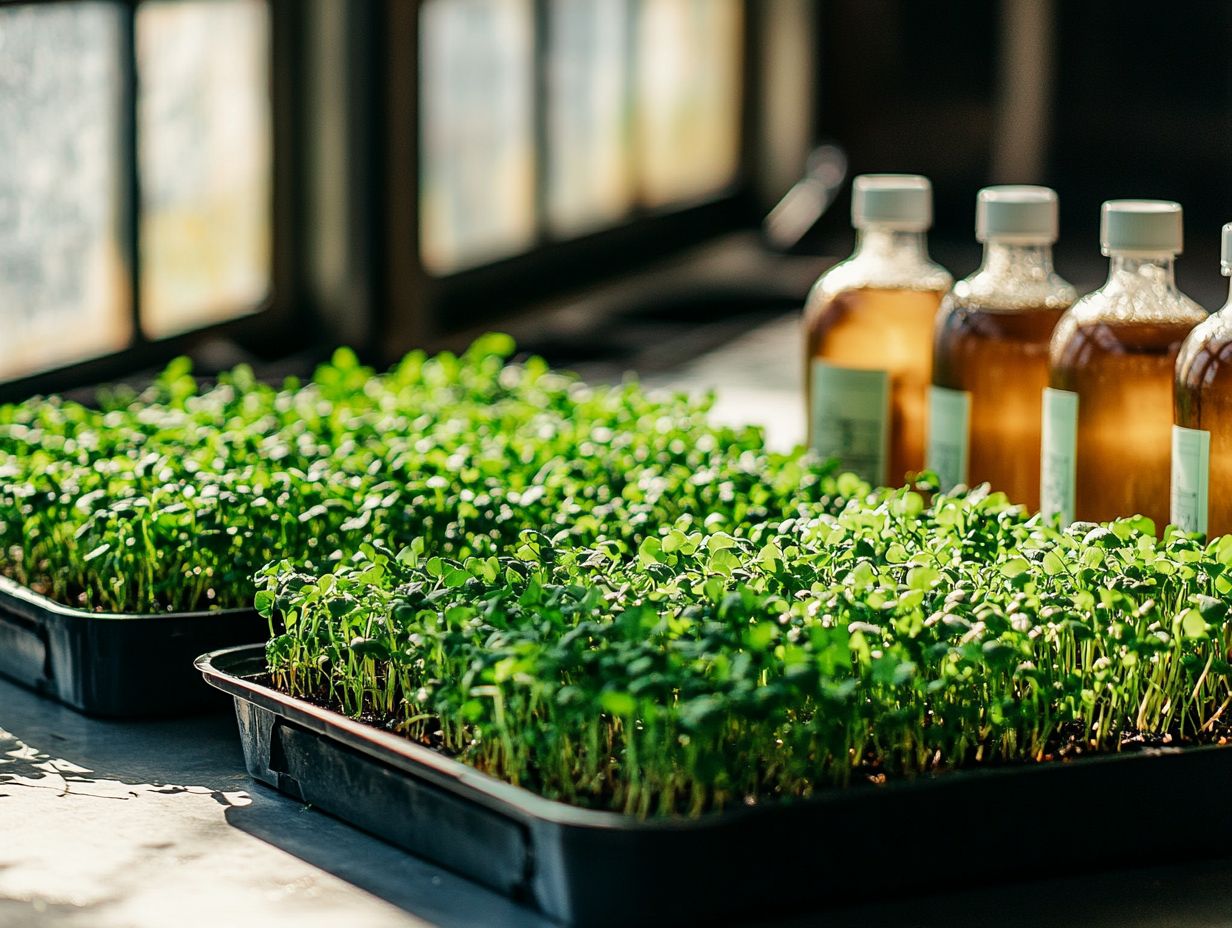
- Choose the right nutrient solution for microgreens based on plant type and growth stage to ensure optimal growth and nutrient absorption.
- Consider water quality and pH levels when selecting a solution to prevent nutrient deficiencies and plant damage.
- Follow step-by-step instructions and avoid common mistakes when mixing and applying nutrient solutions for successful and cost-effective microgreen cultivation.
What are Microgreens?
Microgreens are young, edible plants that you can harvest just after the first true leaves appear. They bring a delightful burst of flavor, color, and nutrition to your plate. You can grow them from a variety of seeds, including popular options like Purple Vienna Kohlrabi and Genovese Basil.
Typically, they thrive in organic and sustainable mediums such as Home Microgreens Potting Mix and coconut fiber. This process not only promotes a healthier lifestyle but also aligns beautifully with environmentally friendly practices. For those interested in expanding their knowledge, exploring innovative methods for hydroponic microgreens can provide valuable insights.
These tiny powerhouses offer an impressive array of nutritional benefits, being rich in vitamins, minerals, and antioxidants. For example, sunflower and pea shoots are recognized for their high protein content, while mustard greens deliver vibrant flavors along with an extensive vitamin profile.
To cultivate microgreens successfully, you ll want to create ideal growing conditions: plenty of light, optimal temperatures, and consistent moisture. This makes them perfect for small spaces like your kitchen or patio.
By choosing organic growing methods and high-quality mediums, you can ensure that your microgreens are not only tastier but that you’re also contributing to sustainable agriculture practices. It s truly a rewarding endeavor.
Benefits of Growing Microgreens
Growing microgreens offers a wealth of advantages, elevating the nutritional profile of your meals while delivering impressive cost savings for home gardeners.
These tiny greens are brimming with vitamins, minerals, and antioxidants, providing exceptional nutritional value per serving compared to their mature counterparts ideal for those who prioritize health!
Growing your own microgreens lets you enjoy the freshness of homegrown produce while saving on grocery bills.
Nutritional Value and Cost Savings
Microgreens are celebrated for their remarkable nutritional value, often boasting higher concentrations of vitamins and minerals than their fully grown counterparts. This makes them a true superfood for health enthusiasts like yourself.
By cultivating these vibrant greens at home, you can enjoy significant cost savings compared to buying them at grocery stores, where prices tend to be inflated due to high demand.
These tiny nutritional powerhouses think kale, radish, and peas are brimming with essential nutrients such as vitamin C, vitamin K, and a variety of antioxidants that can elevate your immune system and support your overall health.
When you consider the costs, growing microgreens at home offers a bountiful harvest for mere cents per serving, while store-bought options often set you back $3 to $5 for a small container.
The freshness of your homegrown microgreens not only enhances the flavor of your dishes but also maximizes their nutrient content, providing you with an economical and healthful choice to elevate your meals.
Get started today and experience the joy of growing your own microgreens!
Types of Nutrient Solutions for Microgreens
Nutrient solutions play a crucial role in the successful growth of microgreens, and the choice between organic and synthetic options can profoundly influence the quality and sustainability of your crop.
Opting for organic solutions, such as Hero Organic Plant Food, fosters healthy growth while prioritizing environmental safety. On the other hand, while synthetic options may deliver quicker results, they often carry potential drawbacks concerning soil health and sustainability.
Your decision sets the tone for your harvest and future growing practices.
Organic vs. Synthetic Solutions
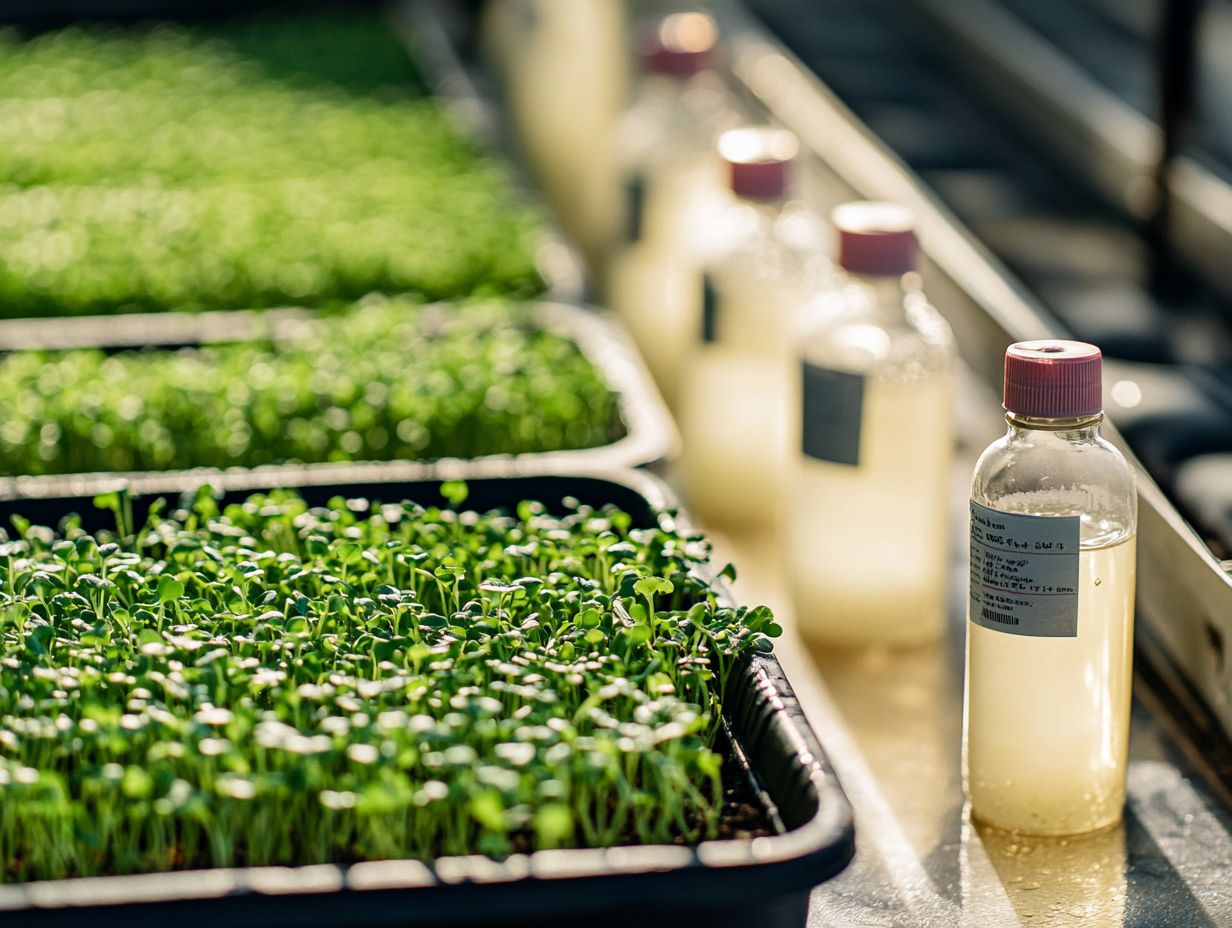
In terms of nutrient solutions for microgreens, you’ll notice a lively debate between organic and synthetic options among growers, each presenting its unique set of advantages and disadvantages. Organic solutions, like Hero Organic Plant Food, not only deliver essential nutrients but also champion environmental sustainability.
On the other hand, synthetic alternatives might offer quicker results but can come at the expense of long-term soil health.
You’ll often find yourself weighing the rapid growth benefits of synthetic fertilizers, such as those containing ammonium nitrate, against the more natural approach of organic options. While organic inputs come from natural sources like compost and fish emulsion, enriching soil biodiversity, they may require a bit more patience due to their slow release.
The ecological footprint of synthetic fertilizers is frequently scrutinized, particularly because of runoff that can lead to water pollution. In contrast, organic methods nurture healthier ecosystems.
Ultimately, your choice between these nutrient sources reflects broader agricultural philosophies and speaks to your commitment to environmental responsibility, significantly influencing both crop quality and sustainability.
Factors to Consider when Choosing a Nutrient Solution
Choosing the perfect nutrient solution can supercharge your microgreens’ growth! It necessitates thoughtful consideration of several key factors, including the type of plant, its growth stage, water quality, and pH levels.
Each microgreen, whether it’s the vibrant Purple Vienna Kohlrabi or the aromatic Genovese Basil, presents unique nutrient requirements throughout its growth phases. This makes it crucial for you to customize the nutrient application to guarantee optimal growth and health for each variety. Additionally, understanding the perfect light conditions for microgreens can further enhance their development.
Plant Type and Growth Stage
The type of microgreens you choose to grow has a significant impact on the nutrient solution needed, as each variety comes with its own unique requirements at different growth stages. For example, Purple Vienna Kohlrabi demands a different nutrient profile than Genovese Basil, especially during their seedling and mature phases.
Understanding the specific nutrient needs of your plants is crucial for optimizing their development. In the early stages, young seedlings thrive on higher nitrogen levels to support lush leaf growth. As these plants mature, however, it’s time to shift focus toward increasing phosphorus and potassium to boost root health and overall yield. To enhance your harvest even further, consider learning how to maximize yields from microgreens.
Adjusting your nutrient solution involves more than just monitoring electrical conductivity (EC), which refers to the ability of a solution to conduct electricity and helps in measuring nutrient levels; you also need to consider light exposure, temperature, and the perfect pH level for microgreens. These factors can significantly influence nutrient uptake.
By adapting your nutrient applications based on growth phases and plant variety, you can cultivate healthier microgreens that flourish at every stage of their lifecycle. Utilizing proper watering techniques for thriving microgreens can further enhance their growth.
Water Quality and pH Levels
Water quality and pH levels are pivotal elements that significantly impact the effectiveness of plant food for your microgreens. By testing the water used for irrigation, you can ensure it falls within the ideal pH range, promoting optimal nutrient absorption and fostering healthier growth with improved yields.
Understanding the right pH, a measure of how acidic or basic a solution is, is crucial. Different microgreens thrive at various levels. For instance, basil prefers slightly acidic conditions, while broccoli flourishes in a more neutral environment. To protect your crops from potential threats, you should also be aware of common pests and solutions for microgreens. Regular testing methods, like pH strips or digital meters, give you the power to monitor and adjust these factors effortlessly.
Good water keeps plants healthy and helps them absorb nutrients. This affects both flavor and vigor.
By maintaining appropriate pH levels, you can maximize your yield and uphold the nutritional integrity of your produce.
How to Mix and Apply Nutrient Solutions
Mixing and applying nutrient solutions with precision is crucial for the thriving growth of microgreens, ensuring they get the nutrients they need for robust development.
Utilizing products such as Hero Organic Plant Food can streamline this process, enabling you to employ straightforward application methods that elevate the growth potential of various microgreen varieties, such as Genovese Basil and Purple Vienna Kohlrabi. For an effective approach, consider learning How to Use Hydroponics for Microgreens.
Step-by-Step Instructions
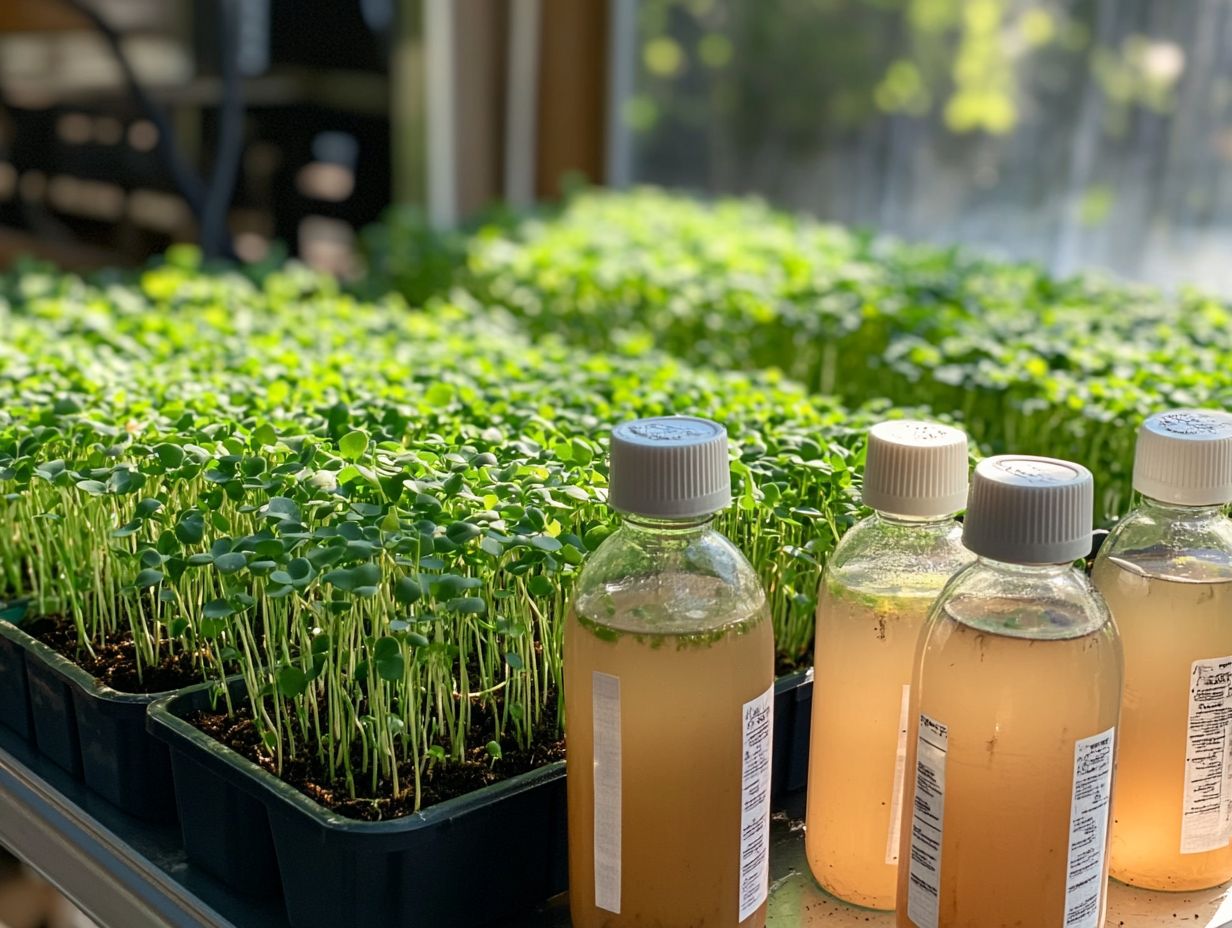
To ensure your microgreens thrive with the optimal nutrients, follow these detailed steps for mixing and applying nutrient solutions effectively, using a quality potting mix like Pro-Mix to support healthy growth.
- Begin by measuring the recommended amounts of your chosen nutrient solution and add them to the water. Mix thoroughly to guarantee an even distribution before application.
- Once you’ve achieved a well-blended solution, checking the pH level becomes essential. Target a pH between 5.5 and 6.5 for optimal nutrient absorption. You can easily do this with a pH meter or test strips, adjusting as necessary to maintain that sweet spot.
- When your solution is primed and ready, pour it gradually over the microgreens, focusing on the roots to minimize moisture on the leaves, which can invite fungal issues. Ensure all seeds or seedlings are evenly drenched so they can fully absorb those nutrients.
For the best results, repeat this process weekly, keeping a close eye on the growth and health of your microgreens. Additionally, consider reading our guide on choosing the right soil for microgreen growth to optimize their environment. This way, you can make informed adjustments as needed to help them flourish and ensure adequate drainage in your containers.
Common Mistakes to Avoid
Growing microgreens is rewarding! However, avoid these common mistakes to ensure your microgreens thrive! From incorrect watering techniques to selecting the wrong plant food, identifying these pitfalls will not only help you troubleshoot effectively but also ensure that your crop remains healthy and vibrant a critical difference for anyone growing houseplants or vegetables.
Troubleshooting and Tips for Success
To achieve healthy growth of microgreens, it s essential to implement effective troubleshooting strategies and follow proven tips throughout the growing process. By addressing common issues like moisture levels, light exposure, and nutrient application, you can significantly enhance your yields and overall success.
Maintaining proper air circulation is crucial to prevent mold and other fungal diseases that could harm your young plants. Also, make sure your growing medium drains well to avoid root rot, a frequent challenge many gardeners face.
Regularly monitoring light conditions is vital, as microgreens flourish with ample yet indirect sunlight or suitable artificial grow lights; this helps prevent leggy growth. Additionally, using natural fertilizers for microgreen growth can enhance their development. Adjusting the timing and quantity of your watering is equally important—overwatering may lead to stagnant growth, while underwatering can stunt development.
By adopting these practical approaches, you can enjoy a bountiful harvest of nutrient-rich microgreens and learn from video lessons shared by experts like Francesco Di Gioia and Caden.
Frequently Asked Questions
What is the importance of choosing the right nutrient solution for microgreens?
Choosing the right nutrient solution is vital for healthy, vibrant microgreens. It also impacts the flavor and look of your final product.
What factors should I consider when choosing a nutrient solution for my microgreens?
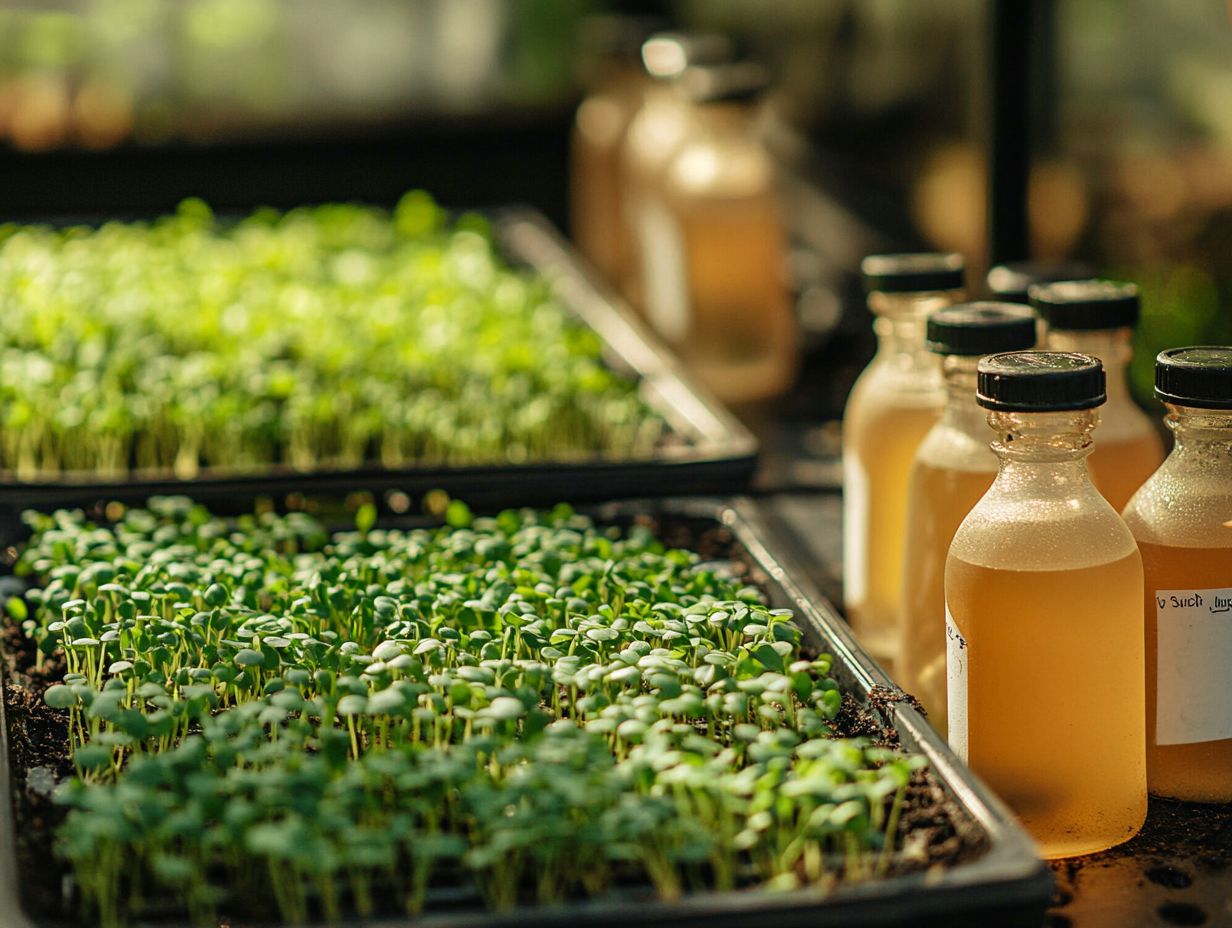
Focus on nutrient ratios, pH balance, and nutrient sources. Remember, different microgreen varieties have unique needs!
Can I make my own nutrient solution for microgreens?
Absolutely! You can create your own nutrient solution with ingredients like seaweed extract or compost tea. Just be sure to measure and balance the nutrients correctly for the best results.
What are the common mistakes people make when choosing a nutrient solution for microgreens?
A frequent error is using the same solution for all varieties, ignoring their unique requirements. Another mistake is neglecting to measure nutrients, leading to stunted growth or deficiencies.
How do I know if my microgreens are receiving the right amount of nutrients?
Watch your microgreens closely. Signs like wilting, yellowing, or slowed growth can indicate nutrient issues!
Are organic nutrient solutions better for microgreens?
Organic solutions can be great, offering natural and sustainable nutrients. Just research and choose a high-quality option for optimal growth!


